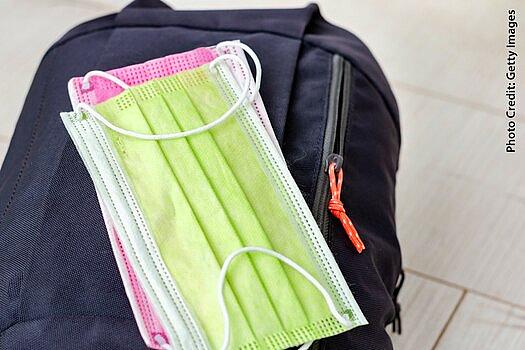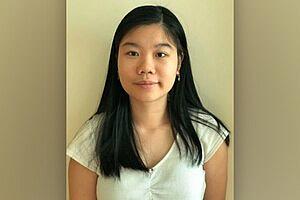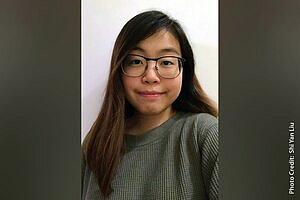Asian American Students Face Bullying Over COVID-19
This story was produced Katherine Kam, a participant in the 2020 California Fellowship.
Her other stories include:
Mental Health an Emerging Crisis of COVID Pandemic
Why domestic violence calls are surging for Asian American women amid the pandemic

Photo Credit : Getty Images
Aug. 20, 2020 -- During a second grade Zoom class in Orange County, CA, a boy said, “I don’t like China or Chinese people because they started this quarantine.”
A Chinese American girl in the class heard those words, and later, she scrawled a handwritten note that her mother posted on Facebook. “This made me feel sad because he’s my friend and I’m Chinese. When you say that you don’t like Chinese people, you’re saying that you do not like me. I did not start this virus. Thank you for being my friend.”
Children haven’t been spared from the racism that Asian Americans have faced since the start of the coronavirus pandemic. The Anti-Defamation League publicized this incident and others on its website. Before schools shut down, Asian American students were taunted and bullied by classmates who blamed them for the disease. Now, as schools start reopening, students and advocacy groups are hoping to combat coronavirus-related bias and scapegoating on campus.
“We absolutely are worried about the bullying of students and how it may dramatically increase,” says Rita Pin Ahrens, executive director of OCA-Asian Pacific American Advocates in Washington, D.C.
In school settings, not only have students spoken blatantly about disliking Chinese people, but there have been physical attacks, too. Before Los Angeles public schools shut campuses in mid-March, bullies in the San Fernando Valley accused a 16-year-old Asian boy of having the coronavirus simply because of his race. They beat him badly enough to send him to the emergency room. During a news conference that was broadcast on CBSN Los Angeles, Debra Duardo, the Los Angeles County superintendent of schools, warned against the climate of fear. “We will not tolerate any type of bullying,” she said.
Today was our first firsthand experience with Anti-Asian Racism related to Coronavirus. . . During her daily zoom...
Posted by Little Gray Thread on Monday, April 20, 2020
Limin Li, 17, a student in Brooklyn, NY, had classmates ask, “You want to go to a wet market together and get corona?” “They think that they’re funny,” she says. But in her view, “these were microaggressions.”
Even after classes migrated online, hate incidents persisted. In April, unknown intruders disrupted a high school Chinese class held on Zoom in Newton, MA. They bombarded the teacher, Lan Lan Sheng Chen, and the students with several minutes of racist images and slurs.
The racism in schools mirrors a broader societal problem of coronavirus-related racism toward Asians. Russell Jeung, PhD, a professor of Asian American Studies at San Francisco State University, helped to launch “Stop AAPI Hate,” a reporting site to track anti-Asian incidents in the U.S. The acronym stands for Asian American Pacific Islander.
From March 19 to July 15, the site had received 2,373 self-reported incidents, according to Stop AAPI Hate. Jeung has called the numbers the tip of an iceberg.
Media reports have described people of Asian descent being coughed or spat upon, pushed, or punched. In March, a man at a Sam’s Club in Midland, TX, thought a Burmese family was spreading the coronavirus and slashed them with a knife. A store employee fought off the attacker, which saved the family from life-threatening injuries. The pandemic has exposed chronic undercurrents of racism, some experts say. “The AAPI community has faced this perpetual foreigner stereotype -- that we don’t belong in this country,” says Pin Ahrens “It is a constant fight for our community to be made welcome in this country.”
Scapegoating in a Hostile Climate
Given the hostile climate, the Anti-Defamation League produced an online anti-bias lesson plan, “Coronavirus and Infectious Racism,” for middle and high school students.
“Our anti-bias training is really focused on addressing all forms of bias,” says Annie Ortega-Long, the education director for the Los Angeles Regional Office of the Anti-Defamation League. “But if we see that there’s really a need to address something specific, like the targeting of people of Asian descent or perceived to be Asian, we’ll focus our activities more on that.”
Brooklyn student Limin Li , 17, was on the receiving end of racist comments about COVID.
The lesson plan’s stated objective: “Expand your understanding of how the coronavirus pandemic is increasing racism against people of Chinese or Asian descent and what you can do about it.” It instructs students on concepts such as racism, bias, and scapegoating. It also explains why the World Health Organization uses the formal, neutral-sounding name “COVID-19” for the disease and why terms such as “kung flu” and “Chinese virus” can increase anti-Asian bias. It teaches students the importance of being allies when they see Asian classmates being harassed.
In a video embedded in the lesson plan, an Asian American high school girl says, “It seems like since the start of the coronavirus outbreak, schools have been a petri dish for racism. It’s dangerous to normalize behavior like this for people my age.”
The Anti-Defamation League’s two dozen regional offices determine how to distribute the lesson plan, Ortega-Long says. During the summer, her L.A. office sent the lesson plan to all contacts on its email list, including educators.
Besides the “Coronavirus and Infectious Racism” lesson plan, the ADL plans to provide more anti-bias training in the coming academic year. Whether on campus or online, the organization will work with K-12 students through its “No Place for Hate”® school program, says Megan Nevels, an assistant education director who oversees the initiative for the Los Angeles area. “No Place for Hate” offers teacher training, and it guides students in planning anti-bias campaigns tailored to issues at their school; for example, a student making a racist post that’s gone viral.
“Students are very clued in to the issues,” Nevels says. “They’re very aware of what’s happening on their campuses -- oftentimes, things that teachers aren’t aware of.”
During the past academic year, 1,600 schools across the country took part in the program, Ortega-Long says. In Los Angeles, interest in “No Place for Hate” has climbed, according to Nevels. “We’re seeing a huge increase in this region. Right now, schools are seeing that they have the coronavirus, the Black Lives Matter movement, and they want to be proactive about addressing their issues on their campuses.”
While Los Angeles will be holding classes online only for now, Mayor Bill de Blasio of New York City has announced plans for the public schools to hold hybrid in-person and remote classes starting in September. The city’s Department of Education and the Office for the Prevention of Hate Crimes have released an online COVID-19 anti-bias guide for educators. It contains numerous resources and lesson plans, including “Asian American Stereotypes,” “Legacies of Chinese Exclusion and Japanese Internment,” “Addressing Hate Online,” and “Speak Up! Responding to Everyday Bigotry.”
The guide encourages teachers to incorporate the lessons into their curriculum. “As educators, we are tasked with creating safe and inclusive spaces for all our students. As always, it is our job to develop empathic and thoughtful individuals who can recognize the value of diversity,” it says.
Asian American Teens Counter Racism
Bullying or harassment of Asian American students because of their race isn’t just a school issue, but violates their civil rights, says Jeff Forte, JD, a special education attorney in Shelton, CT. “Parents of Asian background should understand that if their child is getting bullied at school that they do have rights.”
He suggests that parents record any evidence of bullying. “Get the specific facts down, any witnesses, any photos, if there was written defamation or slander, if there was physical contact that showed any marks or abuse.” Then parents should file an official bullying report with the school district, preferably within 24 hours of the incident, Forte says. School districts must investigate the incident, provide parents with the results in writing, and then put safeguards in place if bullying was confirmed.
In New York City, the nonprofit organization Apex for Youth has worked to prepare teens for coronavirus-related racism, says Yaya Yuan, director of education and mentoring programs. Apex for Youth pairs disadvantaged students, mostly Chinese American, with mentors.
In February, as COVID-19 cases started rising, mentors began asking how to respond to anti-Asian racism, including bullying and insults on the streets. Apex for Youth surveyed 100 of its middle and high school students and found that half were anxious or concerned about anti-Asian racism, and 15% had already experienced an incident, according to Yuan. Many parents were afraid to let their children out in public, not only because of the virus, but also out of fears for their physical safety.
Even though most families faced financial challenges from the pandemic, they wouldn’t allow their children to pick up food boxes or bagged lunches from free programs, Yuan says. “Their parents weren’t going to take advantage of those programs because it meant standing in line, it meant walking down the street and potentially exposing yourself not only to the virus, but to racist comments and violence.”
For youths and adults alike, Yuan’s organization created “How to Talk to Asian American Youth About Racism,” a digital resource guide. It addressed online and physical safety and ways to respond to racism, but only if the setting makes it safe to do so. One tip, for example: “Is the person speaking from a lack of information or malice? Sometimes sharing the facts can open people to a new way of thinking. If they are speaking from a place of hatred, it might make more sense just to walk away.”
Apex for Youth also enabled students to share their experiences with racism, including sponsoring a Zoom conference in May for Asian American teens in New York City. Some students came away with “action plans” to boost awareness and advocacy through social media, says Shi Yan Liu, 16, a Chinese American student in Brooklyn who helped to organize the conference for her peers.
Shi Yan Liu, 16, a Chinese American student in Brooklyn, has been alarmed by media reports of Asian Americans being attacked on the city’s public transit.
Like them, she has been alarmed by media reports of Asian Americans being attacked on the city’s public transit, she says. While she hasn’t experienced racist incidents herself because she’s been sheltering at home, occasional visits to the grocery store have made her uneasy. “When I go outside, I’m always a little paranoid of people just staring at me and my parents. I wonder if they’re staring at us because we’re Asian or if they think we have coronavirus or maybe they’re simply just looking at us.”
She worries, too, about what will happen when in-person schooling starts again. While Liu says she didn’t witness racism toward Asian students before the pandemic, she’s concerned about the coming academic year, especially after a racist incident at her school in January 2020. A swastika, along with a call to kill all Jews, was scribbled in a stairwell, and a racist slur against Black people was found on a restroom wall. Some of the imagery was spread through social media.
“I’m just afraid that because of this pandemic, there might be more incidents where they’re targeting the Asian community,” Liu says.
While students get along in general, she says, “I feel like there’s always a person out there who perhaps isn’t fitting in well, and they decide that doing something like this would bring attention.”
Apex for Youth tries to help teens like Liu understand that anti-Asian racism isn’t about them personally, but fits into a larger historical and societal problem of racism, according to Yuan. “Once George Floyd and the Black Lives Matter uprising began to happen, we also did workshops around Asian American solidarity with the Black community and how what we experience during COVID is related,” she says.
The Black Lives Matter movement provides hope, says Li, who took part in an Apex for Youth virtual town hall about the protests. “We talked about the Black Lives Matter movement and how it’s important for us to be standing in solidarity with other people of color,” she says.
Before her school closed, students would ask her, “Are you from Wuhan? Do you guys eat bats?”
“I didn’t really know how to brush it off, so I would just laugh at them. I think that’s the case for a lot of students, because we don’t know how to speak out against these issues. It puts me in a very awkward and uncomfortable situation.”
As Asians, she says, “we’ve grown up in an environment where we’re told to be silent. We have been portrayed as meek and weak. When we’re faced with issues such as bullying and microaggressions, we’re taught to stay silent and not speak up for ourselves.”
But anti-Asian racism has made her question those messages, she says. Like some of her Asian American friends, she too is using social media, particularly Instagram, to fight racism.
At the start of the pandemic, many of her fellow students mocked and blamed Asians online, she says. But she’s noticed a change among them since Floyd’s death and the protests. “Now that there’s a whole movement for Black Lives Matter, I feel like people have become more educated and enlightened,” she says.
“You can’t isolate a certain group of people. You can’t say that you’re not racist if you support Black Lives Matter, but you are racist against another type of race.”
Katherine Kam wrote this story while participating in the USC Center for Health Journalism‘s 2020 California Fellowship.
[This story was originally published by WebMD Health News.]

